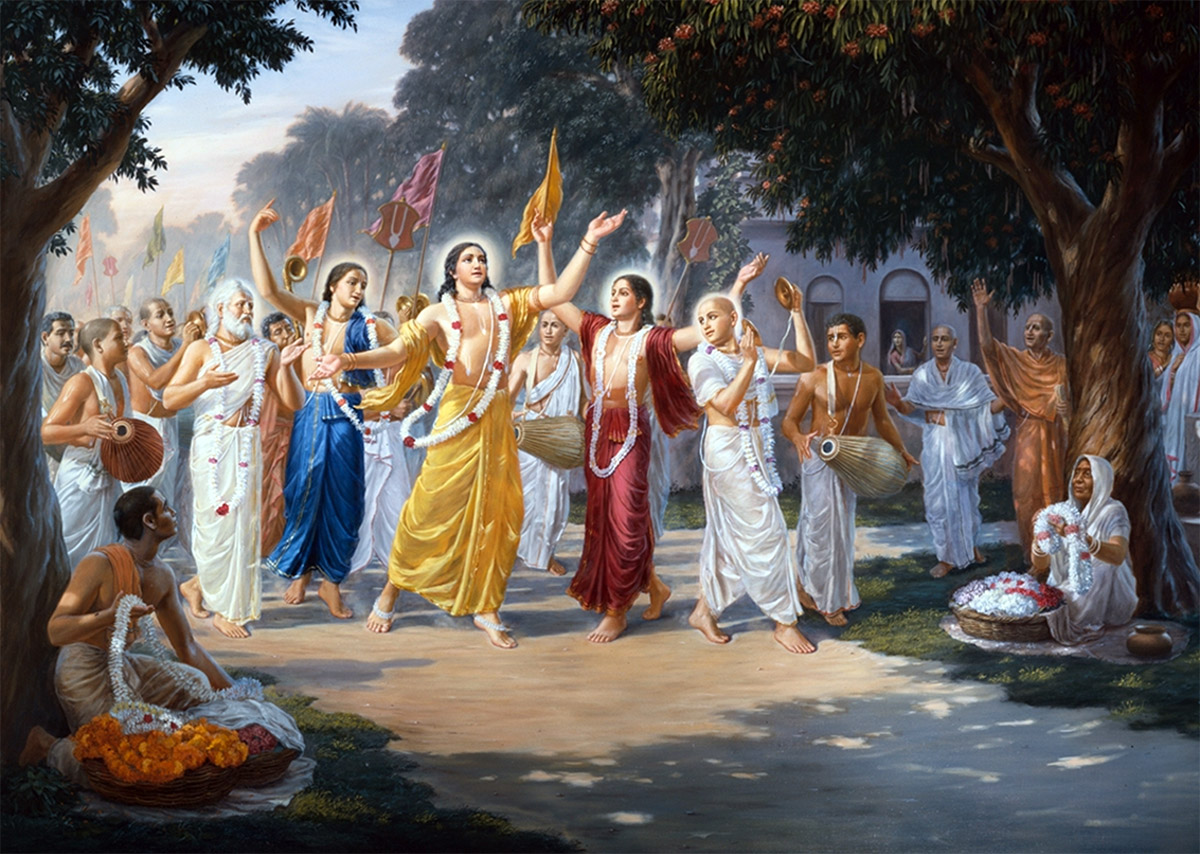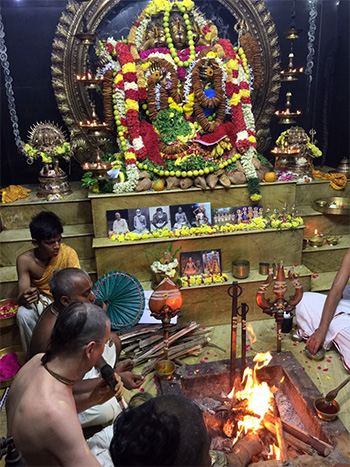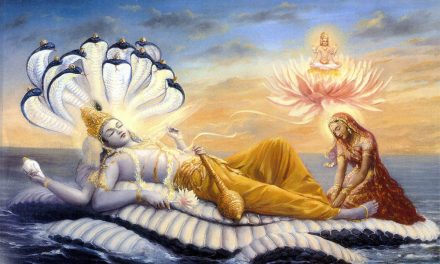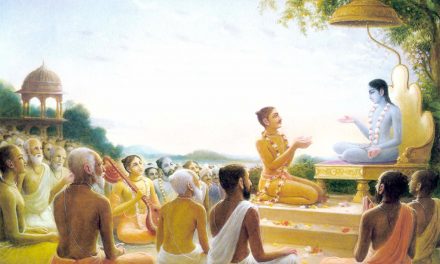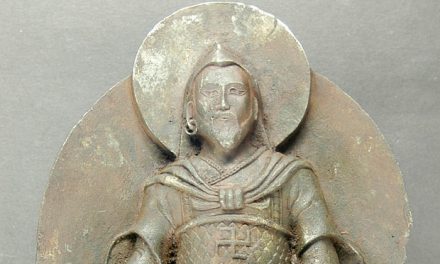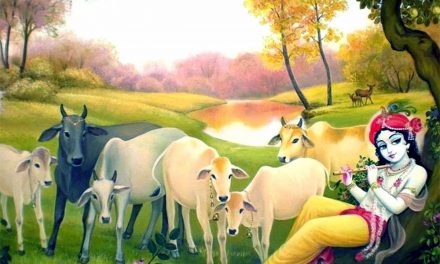Who was Chaitanya Mahaprabhu?
Sri Chaitanya is the Kali-yuga avatara, and He descended for the purpose of establishing the yuga dharma, which in this age is the chanting of Lord Krishna’s names. He appeared in the guise of a devotee to perfectly show how the process of devotion should be followed and applied. It is something like a teacher drawing on the black board “A B C”. We should not think the teacher is himself learning the alphabets, but he is doing it to show us how to write properly.
The inner purpose of Sri Chaitanya’s incarnation was to experience the devotional love that Radharani has for Krishna. He wanted to experience the process of bhakti from the side of the devotee.
In other ages the Lord incarnates along with His weapons for destroying the demons, but in Kali yuga He shows special mercy to the demons by delivering them with nama-sankirtana. In the Kali-yuga there are practically only demons on this earth, so if the Lord were to kill the demons there would be nobody left. Instead He chose to kill the demoniac tendency within the heart of the demons by giving them Krishna bhakti.
Sri Chaitanya is described in the following verse composed by Sri Rupa Goswami:
namo maha-vadanyaya
krishna-prema-pradaya te
krishnaya krishna-caitanya-
namne gaura-tvishe namah
“I offer my respectful obeisances unto Sri Chaitanya, who is the most merciful incarnation. He has appeared in a golden color for the purpose of freely distributing pure love of Krishna.”
In other incarnations, Lord Krishna would require the devotee to first surrender to Him: sarva dharman parityajya mam ekam sharanam vraja. But in the incarnation as Sri Chaitanya, He would go to the non-devotees and freely distribute krishna-prema to all. This is the unique blessing of this age of Kali. Despite it being the most sinful age, the process of self-realization is the simplest and most accessible to all classes of men.
Lord Chaitanya’s incarnation is mentioned and predicted in numerous scriptures. The following are some of the important references.
In the Atharva Veda (Purusha-bodini Upanishad) it is said:
saptame gaura-varna-vishnor ity anena sva-shaktya caikyam etya prante
pratar avatirya saha svaih sva-manum shikshayati
“In the seventh manvantara, the Supreme Lord will, accompanied by His own associates, descend in a golden form. He will teach the chanting of His own holy names.”
It is further stated in the Atharva Veda:
ito ‘ham krita-sannyaso ‘vatarishyami sa-guno nirvedo nishkamo bhu-girbanas tira-stho ‘lakanandayah kalau catuh-sahasrabdhopari panca-sahasrabhyantare gaura-varno dirghangah sarva-lakshana-yukta ishvara-prarthito nija-rasasvado bhakta-rupo mishrakhyo vidita-yogah syam
“The Supreme Lord Himself says: When between four thousand and five thousand years of Kali-yuga have passed, I will descend to the earth in a place by the Ganges’ shore. I will be a tall, saintly brahmana devotee of the Lord, and have a golden complexion. I will be renounced and free from all desire. I will accept the order of renunciation (sannyasa). I will be a devotee advanced in bhakti-yoga. I will chant the holy names of the Lord. I will taste the sweet mellows of My own devotional service. Only the great devotees will understand Me.”
In the Sama Veda the Lord states:
tathaham krita-sannyaso bhu-girbano ‘vatarisye tire ‘lakanandayah punah punar ishvara-prarthitah sa-parivaro niralambo nirdhuteh kali-kalmasha-kavalita-janavalambanaya
“To deliver the people devoured by the sins of Kali-yuga, I will, accompanied by My associates, descend to the earth in a place by the Ganges shore. I will be a brahmana avadhuta sannyasi. Again and again I will chant the holy names of the Lord.”
In the Krishna Upanishad it is stated:
sa eva bhagavan yuge turiye ‘pi brahma-kule jayamanah sarva upanishadah uddidirshuh sarvani dharma-shastrani vistarayishnuh sarvan api janan santarayishnuh sarvan api vaishnavan dharman vijrimbhayan sarvan api pashandan nicakhana
“In the Kali-yuga, Lord Krishna will appear in a brahmana’s family. He will teach the message of the Upanishads and the dharma-shastras. He will defeat the atheists and offenders and He will establish the truth of Vaishnava dharma.”
In the eleventh canto of Srimad Bhagavatam the following verse is found:
krishna-varnam tvishakrishnam
sangopangastra-parshadam
yajnaih sankirtana-prayair
yajanti hi su-medhasah
“In the age of Kali, intelligent persons perform congregational chanting to worship the incarnation of Godhead, who constantly sings the name of Krishna. Although His complexion is not blackish, He is Krishna Himself. He is accompanied by His associates, servants, weapons, and confidential companions.”
In the seventh canto of Srimad Bhagavatam is the following verse describing the Lord’s incarnations:
channah kalau yad abhava tri-yugo ‘tha sa tvam
“Because in Kali-yuga You appear in a covered incarnation, you are therefore known as Tri-yuga (one who appears in only three yugas).”
The incarnation of Sri Chaitanya is a hidden incarnation because He appears in the guise of His devotee. This covered incarnation is confirmed in both the Adi Purana and the Narada Purana in the following verse:
aham eva dvija-shreshtho
nityam pracchanna-vigrahah
bhagavad-bhakta-rupena
lokam rakshami sarvada
“My true identity always concealed, I will assume the form of a brahmana devotee of the Lord. In this form I will deliver the worlds.”
In the Kurma Purana the following statement is found:
kalina dahyamananam
uddharaya tanu-bhritam
janma prathama-sandhyayam
bhavishyati dvi jalaye
“To deliver the conditioned souls burning in the troubles of Kali-yuga, in the first sandhya of that age the Lord will take birth in a brahmana’s home.”
In the Garuda Purana the Lord Himself states:
kalina dahyamananam
paritranaya tanu-bhritam
janma prathama-sandhyayam
karishyami dvi jatishu
“To deliver the conditioned souls burning in the troubles of Kali-yuga, in the first sandhya of that age I will take birth among the brahmanas.”
aham purno bhavishyami
yuga-sandhau visheshatah
mayapure navadvipe
bhavishyami shaci-sutah
“In My original spiritual form, perfect and complete, I will become the son of Shachi-devi in Navadvipa Mayapura at the begining of Kali-yuga.
Sri Chaitanya was born in Mayapura, a subsection of the holy town of Navadvipa, to Shachi-devi in 1486 AD, aproximately 4,500 years after the beginning of the Kali-yuga.
Elsewhere in the Garuda Purana it is said:
kaleh prathama-sandhyayam
lakshmi-kanto bhavishyati
daru-brahma-samipa-sthah
sannyasi gaura-vigrahah
“In the first sandhya of Kali-yuga, the Lord will assume a golden form. First He will be the husband of Lakshmi, and then He will be a sannyasi who stays near Lord Jagannatha at Puri.”
Sri Chaitanya first married His eternal consort Sri Lakshmi-priya Devi before taking sannyasa at the age of twenty-four. After taking sannyasa He left Navadvipa in Bengal, and resided in the holy city of Puri in Orissa. Lord Jagannatha, the presiding deity of Puri is known in the Puranas by the name daru-brahma or “the Lord who is wood”. This is because the Jagannatha deities in Puri are made from Neem wood.
Also in the Garuda Purana:
yo reme saha-ballavi ramayate vrindavane ‘har-nisham
yah kamsam ni jaghana kaurava-rane yah pandavanam sakha
so ‘yam vainava-danda-mandita-bhujah sannyasa-veshah svayam
nihsandeham upagatah kshiti-tale caitanya-rupah prabhuh
“The Supreme Lord who enjoyed pastimes with the gopis, who day and night filled the people of Vrindavana with happiness, who killed kamsa, and who in the war between the Kauravas made friendship with the Pandavas, will come again to the earth. Of this there is no doubt. His arm will be decorated with a bamboo danda (stick), He will be a sannyasi and His name will be Chaitanya.”
The custom is that one begins carrying a bamboo rod (danda) after one takes sannyasa. Sri Chaitanya was an eka-danda sannyasi, thus He carried a single bamboo rod.
In the Devi Purana we find the following statement:
nama-siddhanta-sampatti
prakashana-parayanah
kvacit sri-krishna-chaitanya-
nama loke bhavishyati
“The Lord will again appear in this world. His name will be Sri Krishna Chaitanya and He will spread the chanting of the Lord’s holy names.
Sri Chaitanya perfectly illuminated the glories of the nama-siddhanta as predicted in this verse.
In the Nrisimha Purana it is mentioned:
satye daitya-kuladhi-nasha-samaye simhordhva-martyakritis
tretayam dasa-kandharam paribhavan rameti namakritih
gopalan paripalayan vraja-pure bharam haran dvapare
gaurangah priya-kirtanah kali-yuge caitanya-nama prabhuh
“The Supreme Lord, who in the Satya-yuga appeared as a half-man half-lion to cure a terrible disease that had ravaged the daityas, and who in Treta-yuga appeared as Rama, a person who defeated the ten-headed Ravana , and who in Dvapara-yuga removed the earth’s burden and protected the gopa people of Vraja-pura, will appear again in the Kali-yuga. His form will be golden, He will delight in chanting the Lord’s holy names, and His name will be Chaitanya.”
In the Padma Purana we find the following statement from the Lord:
kaleh prathama-sandhyayam
gaurango ‘ham mahi-tale
bhagirathi-tate ramye
bhavishyami shaci-sutah
“In the first sandhya of Kali-yuga I will appear on the earth in a beautiful place by the Gange’s shore. I will be the son of Shachi-devi and My complexion will be golden.”
In the Narada Purana the Lord says:
aham eva kalau vipra
nityam pracchanna-vigrahah
bhagavad-bhakta-rupena
lokan rakshami sarvada
“O brahmana, in the age of Kali I will appear disguised as a devotee of the Lord and I will deliver all the worlds.”
divija bhuvi jayadhvam
jayadhvam bhakta-rupinah
kalau sankirtanarambhe
bhavishyami shaci-sutah
“O demigods, in the Kali-yuga take birth as devotees on the earth. I will appear as the son of Shachi in Kali-yuga to start the sankirtana movement.”
Nama-sankirtana, or the chanting of the Lord’s names is the yuga dharma for the age of Kali. Establishing this was Sri Chaitanya’s primary purpose for incarnating.
In the Bhavishya Purana we find:
anandashru-kala-roma-
harsha-purnam tapo-dhana
sarve mam eva drakshyanti
kalau sannyasa-rupinam
“O sage whose wealth is austerity, in the Kali-yuga everyone will see My form as a sannyasi, a form filled with tears of bliss and bodily hairs standing erect in ecstacy.”
Sri Chaitanya would always display such symptoms of pure love of Krishna. When chanting the names of the Lord tears would flow from His eyes, and the hair on His body would stand erect. In his life Sri Chaitanya personally only composed eight verses known as Shikshashtakam. In the sixth verse He states:
nayanam galad-ashru-dharaya
vadanam gadgada-ruddhaya gira
pulakair nicitam vapuh kada
tava nama-grahane bhavishyati
“O my Lord, when will my eyes be decorated with tears of love flowing constantly when I chant Your holy name? When will my voice choke up, and when will the hairs of my body stand on end at the recitation of Your name?”
Then in the seventh verse He says:
yugayitam nimeshena
cakshusha pravrishayitam
shunyayitam jagat sarvam
govinda-virahena me
“O Govinda! Feeling Your separation, I am considering a moment to be like many years. Tears are flowing from my eyes like torents of rain, and I am feeling all vacant in the world in your absence.”
These emotional symptoms of devotion were constantly being displayed by Sri Chaitanya.
In the Matsya Purana the following statement is made by the Lord:
mundo gaurah su-dirghangas
tri-srotas-tira-sambhavah
dayaluh kirtana-grahi
bhavishyami kalau yuge
“In the Kali-yuga I will take birth in a place where three rivers meet. I will be golden color and tall. I will have a shaven head. I will be very merciful, and I will eagerly chant the holy names.”
The place where three rivers meet is Navadvipa. It is the custom that eka-danda sannyasis completely shave their head when they take sannyasa, and Sri Chaitanya followed this principle.
This same verse is also found in the Vayu Purana with just two words appearing differently. The Vayu Purana verse mentions the Ganges river instead of ‘three rivers’.
In the Vamana Purana the Lord says:
kali-ghora-tamas-channat
sarvan acara-var jitan
shaci-garbhe ca sambhuya
tarayishyami narada
“O Narada, taking birth in Shachi-devi’s womb, I will deliver the sinful people from the terrible darkness of Kali-yuga.”
In the Vayu Purana the Lord states:
paurnamasyam phalgunasya
phalguni-riksha-yogatah
bhavishye gaura-rupena
shaci-garbhe purandarat
“In the month of Phalguna, when the star phalguni is conjoined with the full moon, I will appear in a golden form begotten by Purandara in Shachi-devi’s womb.”
Sri Chaitanya’s father was known by the names Purandara Mishra and Jagannatha Mishra. Sri Chaitanya was born on the full moon day of the month of Phalguna.
svarnadi-tiram asthaya
navadvipe janashraye
tatra dvi ja-kulam prapto
bhavishyami janalaye
“I will take birth in a brahmana family in the city of Navadvipa, by the Ganges shore.”
bhakti-yoga-pradanaya
lokasyanugrahaya ca
sannyasa-rupam asthaya
krishna-chaitanya-nama-dhrik
“In order to show mercy to the people and engage them in devotional service, I will accept sannyasa. Then My name will be Sri Krishna Chaitanya.”
In the Ananta Samhita we find:
svarnadi-tiram ashritya
navadvipe dvijalaye
sampradatum bhakti-yogam
laksyanugrahaya ca
“To show mercy to the people and give them devotional service, the Supreme Personality of Godhead will appear in a brahmana’s home in Navadvipa by the Gange’s shore.”
Then the Lord states:
avatirno bhavishyami
kalau nija-ganaih saha
shaci-garbhe navadvipe
svardhuni-parivarite
“In Kali-yuga I will descend to the earth with My associates. In Navadvipa, which is surrounded by the Ganges, I will take birth in Shachi-devi’s womb.”
In the Urdhvamnaya Tantra it is mentioned:
kalau purandarat shacyam
gaura-rupo vibhu smritah
“In kali-yuga I will appear in a golden form as the son of Purandara and Shachi-devi.”
In the Krishna-yamala it is stated:
aham purno bhavishyami
yuga-sandhau visheshatah
mayapure navadvipe
varam ekam shaci-sutah
“During the first sandhya of Kali-yuga I will descend, with all My powers and glories, to Mayapura in Navadvipa and become the son of Shachi-devi.”
In the Brahma-yamala:
athavaham dhara-dhamni
bhutva mad-bhakta-rupa-dhrik
mayayam ca bhavishyami
kalau sankirtanagame
“I will appear on the earth in the garb of My devotee. In the Kali-yuga I will appear in Mayapura to start the sankirtana movement.”
kalau prathama-sandhyayam
hari-nama-pradayakah
bhavishyati navadvipe
shaci-garbhe janardanah
“In the first sandhya of kali-yuga, Lord Krishna will appear in Navadvipa, in Shachi-devi’s womb. In that incarnation He will teach the chanting of Lord Hari’s holy names.”
In the Ananta Samhita we find:
gauri shri-radhika devi
harih krishna prakirtitah
ekatvac ca tayoh sakshad
iti gaura-harim viduh
“The golden Goddess Radha is known by the name Gauri and the dark Lord Krishna is known by the name Hari. Aware that both of them have combined, the wise call Him as Gaurahari.”
navadvipe tu tah sakhyo
bhakta-rupa-dharah priye
ekangam shri-gaura-harim
sevante satatam muda
“O beloved, assuming the forms of devotees the gopis will also take birth in Navadvipa. With great happiness they will again and again serve Lord Gaurahari, who is Radha and krishna combined in a single form.”
In the Krishna-yamala we further find:
iti matva kripa-sindhur
amshena kripaya harih
prasanno bhakta-rupena
kalav avatarishyati
“Thinking in this way, Lord Krishna, who is an ocean of mercy, mercifully decided to appear as a devotee in Kali-yuga.”
gaurango nada-gambhirah
sva-namamrita-lalasah
dayaluh kirtana-grahi
bhavishyati shaci-sutah
“His limbs will be golden and His voice deep. He will be very merciful. He will yearn to taste the nectar of His own holy name. He will be attached to chanting His own holy name. He will be the son of Shachi-devi.”
In the Jaimini-bharata it is said:
anyavatara bahavah
sarve sadharana matah
kalau krishnavataras tu
gudhah sannyasa-vesha-dhrik
“Lord Krishna descends to the world in many different forms. However in Kali-yuga, His incarnation is hidden. At that time He appears disguised as a sannyasi.”
In the Yoga-vashishtha we find:
kaleh prathama-sandhyayam
gaurango ‘sau mahi-tale
bhagirathi-tate ramye
bhavishyati sanatanah
“In the first sandhya of Kali-yuga, on the earth, by the beautiful shore of the Ganges, the Lord will appear in His eternal golden form.”
In the Skanda Purana:
antah krishna bahir gaurah
sangopangastra-parshadah
shaci-garbhe samapnuyam
maya-manusha-karma-krit
“Outwardly of golden complexion, but inwardly Krishna, I will take My birth in the womb of Shachi-devi. Accompanied by My associates, servants, weapons, and confidential companions, I will assume the role of a human being.”
In the Kapila Tantra we find the following statements:
kvacit sapi krishnam aha
shrinu mad-vacanam priya
bhavata ca sahaikatmyam
icchami bhavitum prabho
mama bhavanvitam rupam
hridayahlada-karanam
parasparanga-madhya-stham
krida-kautuka-mangalam
paraspara-svabhavadhyam
rupam ekam pradarshaya
shrutva tu preyasi-vakyam
parama-priti-suchakam
svecchayasid yatha purvam
utsahena jagad-guruh
premalingana-yogena
hy acintya-shakti-yogatah
radha-bhava-kanti-yuktam
murtim ekam prakasayan
svapne tu darshayam asa
radhikayai svayam prabhuh
“Then Sri Radha said to Lord Krishna: O beloved, please hear My words. I yearn to become one with you. Please show a form where You and I embrace and Our two bodies become one, a form filled with the love I bear for You, a form filled with auspicious and blissful pastimes, a form that brings bliss to the heart, a form that unites Our two natures.’
“Hearing His beloved’s words, which were filled with joy and love, Lord krishna passionately embraced Her. Then by the touch of His inconceivable potency Their two forms joined and became one, a single form endowed with Sri Radha’s divine love and glorious splendour. In a dream Lord Krishna showed all this to Sri Radha.”
Other direct references are found in the Vishvasara Tantra, Kularnava Tantra, Brahma-rahasya, and Vishnu-yamala. Besides these there are complete chapters about Sri Chaitanya’s incarnation in the Vayu Purana and Bhavishya Purana, which are too long to quote here. Also there is a text by the name Chaitanya Upanishad within the Atharva Veda, which explains the Lord’s incarnation in Kali-yuga. I have not cited it here, as it was rediscovered in recent times, so most people will reject it’s authenticity, or at least its value as evidence.
Sri Chaitanya’s incarnation was a hidden incarnation, thus He burried references to His appearance deep within the ocean of vedic texts. His desire was that His disguise would not be betrayed, so He made sure these references would remain hidden until after His incarnation was complete. These text’s were always present, but by the inconceivable yoga-maya of the Lord, He covered His true identity even from the Vedic scholars and panditas. Only the pure devotees understood His actual identity.
In the Ananta Samhita we find this very relevant statement regarding Sri Chaitanya’s incarnation:
aprakashyam idam guhyam
na prakashyam bahir mukhe
bhaktavataram bhaktakhyam
bhaktam bhakti-pradam svayam
man-maya-mohitah kecin
na jnasyanti bahir-mukhah
jnasyanti mad-bhakti-yuktah
sadhavo nyasino ‘malah
“Those who are bewildered by My illusory potency will not understand the great secret of My appearance in this world in My personal form, in My form as the incarnation of a devotee, in My form bearing the name of a devotee, in My form as a devotee, and in My form as the giver of devotional service. This secret is not to be revealed to them. Only the saintly, pure, renounced devotees, diligently engaged in My devotional service, will be able to understand Me in these forms.”
Questions and Answers:
Question: What do the Vedas say about the suffering a new-born baby is under going, through no apparent fault of its own? I have heard that karma is the answer, but how does a new born child suffer any past life sins when it cannot even be sure of its existence, till its sustainable stage.
All our experiences of suffering and enjoyment are due to activities we have performed in previous lives. No one can trace out the origin of our embodiment, thus sometimes it is described as beginningless. We have gone through millions and millions of lives, sometimes as animals, sometimes as trees, and at present as human. The nature is designed to perfectly reward and punish us for the good and bad actions we perform. The Paramatma is the witness to all of our activities, and thus our results are perfectly calculated. Every suffering we undergo is because we have caused similar sufferings to other living entities in the past. Simply because we have forgotten the crime does not mean we are innocent. The laws of nature are so stringent and firm that they punish everyone regardless of one’s present ignorance. If a small baby touches fire he will be burnt. His ignorance does not protect him from the fire. He may not know that fire burns, but the natural law is rigid and firm. In a similar manner, the laws of karma are firm and precise. Simply because of forgetfulness or ignorance we will not be pardoned for our incorrect actions.
It is not only suffering, enjoyment is equally rigid. The young baby does not know what good he has done, yet he enjoys. This is the law of karma.
It is actually the mercy of Krishna that we forget our previous lives. In the Gita Krishna says: mattah smritir jnanam apohanam ca, “I give remembrance, knowledge and forgetfulness.” Imagine if we were to remember every life we had gone through. Complete remembrance of all of our sufferings, all of our mistakes, all of the loved ones whom we had lost. Within one life our mind is so disturbed by thoughts of the past – anxieties, longings, sadness. We are unable to break attachments to matter voluntarily, so Krishna gives a second chance by suppressing these thoughts to a deeper level of mind, creating a blank sheet for us to start over. Imagine the minds of the murderers, criminals, and cruel people. We have been all of these categories, but by the mercy of God we have forgoten our evil actions. To know all of the sinful activities we have performed will drive a man insane.
If I was the King of England in my last life, how would I feel today to be born in a poor family with no money or food? I would remember all of my previous habits and likings, yet I would not even be able to feed myself. If I had loved someone in a previous life, that longing would remain forever, despite that person no longer living. Forgetfulness of our previous lives enables us to start fresh with a clean slate.
Why is one child born in poverty and another born in opulence. Why is one child born with a disease and another born healthy. It is all due to their actions in their previous lives. Ultimately we must become free from this cycle of birth and death. Only then can we truly experience our natural happiness.
Even though the Lord has given us forgetfulness of our previous lives, still He gives us the opportunity to revive that knowledge if we wish. He has not erased the information, He has only suppressed it. Through a particular sadhana and meditation it is possible to bring back that knowledge, but it serves no practical purpose other than to increase one’s attachments and anxieties.
Question: Are there references to other religions such as Christianity and Islam within the Vedic texts?
Thank you for writing. There is a text by the name Bhavishya Purana (which means literally the ‘History of the Future’), in which predictions of the present age of Kali are given. The book was written by the sages 5,000 years ago, before the Kali yuga began. Through their mystic vision they were able to foresee many events that would take place in the Kali yuga, and for the benefit of humanity they put them down in writing. Some of the events described include the appearance and activities of Jesus Christ (whom it is revealed came to India and spent much time at Puri in Orissa, as well as in the HImalayas), the appearance of Mohammed, and many others. Jesus is described as coming from the planet of the Sun, and is given the name Isa-putra or “son of God”. Mohamed is described as coming from the Kailasha planet, which is the abode of Lord Siva. In both cases they were sent to establish non-vedic dharma to put a degraded civilization back on the track of God consciousness.
Question: I am doing a project on Hinduism and was wondering if you could give me some insight on what hinduism is really about, especially in regards to the concepts of Brahman, Atma, Maya, Karma, and Moksha.
Brahman is the absolute truth. It possesses three spiritual qualities, namely eternality, knowledge, and bliss. Brahman is the cause of all causes, from whom everything comes, by whom everything is maintained, and into whom everything enters after dissolution. Brahman is spiritual, it is situated beyond material qualities and material duality. Some schools of philosophy consider Brahman to be impersonal, others consider Brahman to be the supreme original personality of Godhead.
The Atma refers to the individual living entity as a spirit soul. The atma is one in quality with the Brahman, that is he is of the same spiritual nature, but in quantity he is infinitesimal. It is like a drop of ocean water and the ocean. Though a drop of ocean water may contain the same minerals as the ocean, we cannot consider the drop of ocean water to be the ocean. They are one in quality, different in quantity. There are unlimited individual atmas. Some philosophers consider the individuality of the atma to be eternal, others believe the atma eventually merges back into the Brahman and loses its individuality.
The Brahman is like a fire, and the Atma is like the small sparks that fly out of the fire. Due to their microscopic nature, the small sparks have a tendency to be extinguished. In a similar matter, the infinitesimal atmas have a tendency to be overpowered and covered by illusion, or Maya. The illusion that covers the atma’s true knowledge causes him to falsely identify himself as a product of matter. To accommodate the polluted consciousness of the soul, the nature creates a series of coverings, or koshas, moving from subtle to gross. The congregate of these coverings is what is generally referred to as the body. According to the pollution of the soul’s consciousness he will be given a suitable body, either as a human, animal, plant, or any one of 8,400,000 species of life.
Once embodied, the soul becomes entangled in a chain of actions and reactions, known as Karma. Every moment we are performing thousands of actions, even unknowingly, and these are all creating seeds of reactions which we must later experience either in this life or another. In order to properly receive our due reactions, the nature creates a new suitable body for us to enter at the time of death. Thus we are entrapped in a seemingly endless cycle of actions and reactions.
Only by acting fully in the service of God, offering the fruits of all our actions to God, can we become free from the reactions, or karma. As one engages in the service of God, one’s built up karmic reactions are slowly burnt up, and one becomes free from future bondage. By becoming free from the bondage of our karmas, and by realizing our true nature as a spirit soul (atma) distinct from the body, we remove the coverings of illusion (maya).
When one is free from the illusion of false identification with the body and its possessions, and when one is resituated in his own spiritual form, that state is known as Moksha, or liberation. Some schools of philosophy believe that the atma becomes one with Brahman. Other schools believe the atma is an eternal individual spiritual person, and at the point of moksha he attains the spiritual abode of God, known as Vaikuntha.
The main scriptural book followed by Hindus is the Bhagavad Gita. Other books, such as the Vedas and Upanishads, are mostly only used in rituals. These books are all written in a language called Sanskrit, which is no longer spoken in India. Sanskrit is somewhat similar to Latin in that most the scriptural texts are written in it, but very few people understand it.
Modern western scholars date the age of these Vedic texts to between 1,000 and 3,500 years. In reality these texts are eternal. This Vedic knowledge is present in the ethereal space in all places and spanning all times. The original sound vibration pranava (Om) is the seed of all matter. The recitation of Vedic mantras can be heard in the ether even now through internal meditation. These texts are not authored, but revealed during one’s meditation.
Receive our daily email newsletter on Hinduism, Yoga, Meditation, Ayurveda and Natural Healing.

